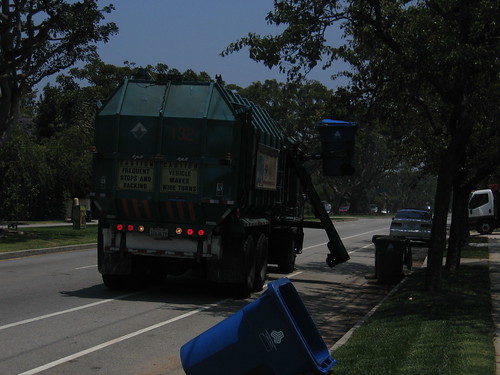»In which density proves troublesome for trash
The New York Times has an article on the meagre cost-savings efforts underway in New York. As the world's largest garbage-collection entity (25,000 tons, or eight full floating barge-loads, daily), they should be able to find efficiency in operations and methods -- but no, the automation of curbside collection is hamped by street parking (probably a major source of revenue for the city, and thus an obstacle that cannot easily be overcome).
They're trying to squeeze a sponge that's already pretty dry," said Ben Miller, a former sanitation official and author of "Fat of the Land," a history of New York City trash. "At this point, reducing crews and increasing automation much more would probably slow things down in certain parts of the city."Under the proposed contract, which still must be considered by the union's members, one worker would operate each of the city's so-called roll-on trucks, which collect the 15-ton steel containers often used in public housing projects, public schools and city hospitals. Currently at these stops, one worker drives the truck and handles the hoisting controls while the other helps guide the truck back into position and then attaches a cable to the Dumpster, which is dragged up the rails on the back of the truck.
For the biggest savings, the mayor would need to consider moving to one-person collection crews not just for the city's 50 roll-on trucks but also for the 2,200 rear-loading trucks, which are used to collect the trash that city residents leave curbside.
Mr. Miller said that one way to make such a change would be for the city to switch to fully automated side-loading collection trucks. These trucks use a side-mounted mechanical arm to pick up special metal containers and they enable drivers never to have to leave the wheel.
But that would be easier said than done. Side loaders, which are already being used in certain neighborhoods in Los Angeles, would be difficult to operate in Manhattan, where parked cars obstruct access, Mr. Miller said. The trucks might be an option, however, for certain sections of Staten Island, Queens and Brooklyn, he said.
I saw the Los Angeles trucks in action recently.

San Franciso has both automatic curbside collection and single-person crews on many of the trucks working residential routes. Barcelona's Neta has many specialised trucks and crews for overcoming the challenges of narrow streets, and also relies on public co÷peration to collect trash in community bins, as does Dublin.

